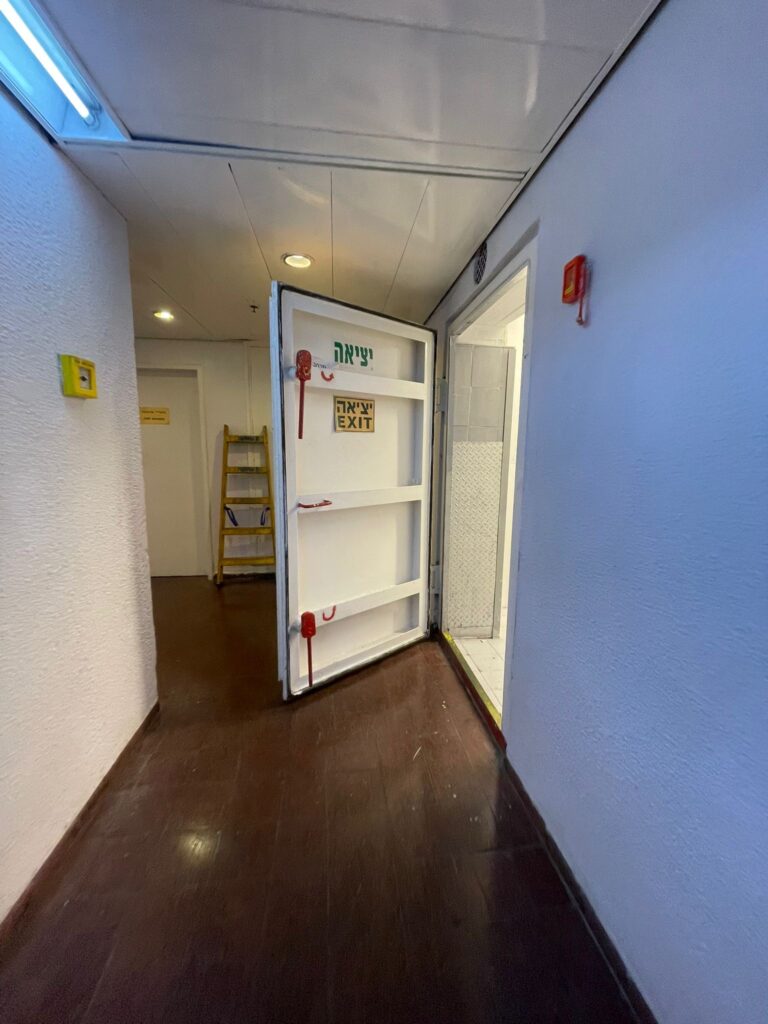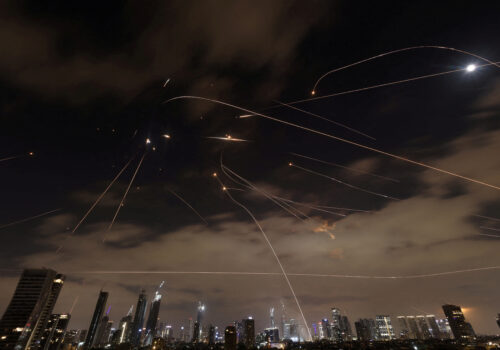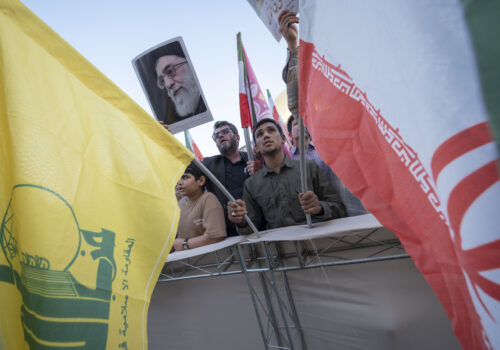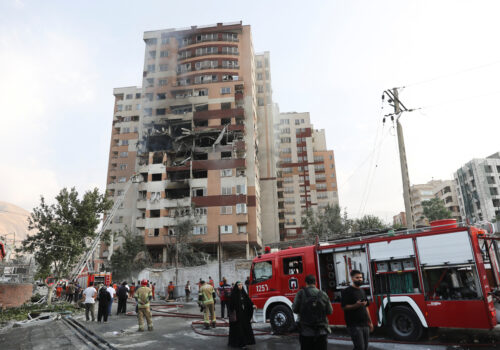Dispatch from Jerusalem: Inside Israel’s bunkers as Iran war erupts
JERUSALEM—As the El Al gate agent smirked and handed my passport back to me, she asked if I was scared to fly to Israel after the US decision that day to evacuate military and diplomatic personnel from the Middle East. I responded with a confused smile and rushed to the aircraft. Little did I know that I would land at the epicenter of a raging civilizational Israeli-Iranian war—one that might redefine the entire Middle East.
The two countries have come close to a full-fledged war since October 7th, 2023, but tit-for-tat strikes and proxy warfare have so far paled in comparison to the almost week-long apocalyptic scenes of raining missiles from one side and the other. The gloves are off this time, and the world is in disbelief. The stakes are higher as two opposing rhetorics about the region’s future are at play: Pan-Abrahamism and Revolutionary Islamism.
The bomb shelter diaries
It’s three am on Friday in Jerusalem, and deafening sirens wail, disturbing the peaceful sleep of our American delegation, which was just reassured a few hours earlier at a dinner with a US official that “nothing will happen.”
Then, Israel hit Iran. Strategic military and nuclear facilities in Iran crumpled under Israeli fire, and a dozen Iranian military leaders and scientists lost their lives in the shadow of the night.
While rushing to find cover in a bomb shelter three floors down the hotel, barefoot in my pajamas, my eyes caught the sight of Tal, a five-year-old Orthodox Israeli boy with his family. This young person appeared to be going through the security motions unbothered by the enormity of the situation, and the imminence of an Iranian retaliation strike. Since the 1991 Scud missile attacks by Iraq’s former dictator, Saddam Hussein, the Israeli society has developed a cutting-edge early detection and sheltering system, which includes fortified safe rooms in every habitat, larger shelters around each neighborhood, and a series of mobile applications and procedures developed by the central home command.

Tal and other Israelis with whom our group became acquainted over our four long sleepless nights, dictated by the tempo of the hundreds of Tehran’s clumsy missiles, are the embodiment of the Israeli spirit and resilience. While trans-national Arab and Persian media try to portray the citizens of Israel as scared and fearful, the reality we witnessed first-hand is far from that. Locals who shared our confinement were all disciplined, united, and had a shared understanding of how vital this conflict is for their nation. The long nights at the bunker teach you a lot about a nation. In spite of the fatigue and psychological warfare imposed by Iran, we only saw a mix of singing, praying, and passing along ice cream to combat the summer heat in the Judean Desert.

The unholy alliance of the Iranian octopus
One recurrent theme kept coming up in all the discussions with Israeli officials and journalists, who generously visted our hotel to brief us on the events, as we were ordered to remain confined near our anti-bomb shelter: The necessity to cut the head of the Iranian octopus after removing many of its tentacles in the region, like Hezbollah in Lebanon and the now-ousted regime of Bashar al-Assad in Syria. Tehran has been posing an existential threat to the safety and continuity of the state of Israel through its proxies in the region. Iran’s development of a proxy network also has been aimed at reshuffling the Sunni-Shia balance of power in the Middle East, establishing Iranian dominance, and exporting its Islamic Revolutionary Model.
One high commander we spoke with at the Israeli Defence Forces (IDF), argued that what the Americans might be too naïve to grasp is that Tehran never stopped implementing Qassem Sulaimani’s vision for the Middle East, and that the nuclear negotiations are but an attempt to buy more time to achieve not only the bomb—but their ideological ambitions. However, many inconsistencies persist in the supreme leader’s discourse, especially the moral dilemma caused by the anomalous coalition with Muslim Brotherhood offshoots like Hamas and the Islamic Jihad in the Gaza Strip, which are the same frictions that were killing Shia populations in Syria and Iraq during the Islamic State of Iraq and al-Sham’s (ISIS) conflict.
SIGN UP FOR THIS WEEK IN THE MIDEAST NEWSLETTER
The Islamic Republic’s octopus constructed its complex web of proxies based on doctrinal affinities with Shia minority groups across the Middle East. At its heart, Iran might be a purely pragmatic international actor more concerned with regional hegemony and power balance, but it still needed to keep a religious Twelver façade to justify its theocratic nature. Iran already adopted a larger definition of Shiism when it allowed controversial Shia sects like the Syrian regime’s Alawite creed and the Houthis’ Zaydi movement to join its zone of influence. With Hamas joining the party, it became a “stinky unholy alliance,” as Israeli Channel Twelve’s Ohad Hamou described it in my chat with him on the morning after the first series of retaliatory ballistic missiles hit Jerusalem and Tel Aviv. Ultimately, supporting Hamas in the October 7th terrorist attacks was the demise of Iran’s strongest proxy, Hezbollah, and is a direct casualty of the Israel-Iran war we are seeing today.
A war of symbols and rhetoric
On this delegation trip to Jerusalem, one of the leading Israeli Abraham Accords architects told us that “this is a war of imaginations, where each side wants to imagine a Middle East in its own image.” This troubled region is no stranger to civilizational clashes. Israel’s Arab and Muslim-majority neighbors have been unable to move beyond the 1948 Arab Nakba, and many have built their entire national identity in opposition to the state of Israel. Minutes before rushing again underground to the bunker, another Israeli who works at a media watchdog warned us not to be fooled, “This is not about the bomb. It’s about ideological dominance.”
Using Aristotle’s rhetorical appeals, Israel and the global West embody the values of the Greek ethos and logos (credibility and logic) that favor discipline, hard work, and a human-centric disenchanted world vision, which is proper to the Judeo-Christian civilization that underwent a drastic metamorphosis after the Renaissance.
In contrast, the Shia axis draws its legitimacy from politicizing the past and the power of the mythos and pathos in Twelver Shia mythology and sentimentalism. This is a dogma that believes it has a historical duty since the great discord between Ali Ibn Abi Talib and Muawiya Ibn Abu Sufiyan to stand with the subaltern underdogs against global hegemons, as displayed by Khomeini’s famous portrayal of the United States as the “Great Satan.” The side that will win this ongoing war will get to reshape the region—a view not necessarily shared by all of the Iranian society.
Equally crucial as US President Donald Trump’s sixty-day ultimatum to the regime in Tehran to reach a nuclear deal with Washington is the symbolism of attacking Iran on the celebration of Eid Al Ghadeer. The day commemorates Imam Ali’s appointment as the successor of Prophet Mohammed—a historical event intimately intertwined with the Iranian doctrine of Wilayat al-Faqih, or “Guardianship of the Islamic Jurist,” which ideologically legitimizes the Iranian theocracy itself since the Islamic Revolution.
Similarly, Israel chose an emblematic appellation for its latest operation, “Rising Lion,” as a nod to Iran’s pre-1979 flag, calling upon the people to rise against the clergy. On the other side, Iran has consistently named its military arsenal after its religious symbols and presumed martyrs, like the Haj Qassem missile, which was launched over Tel Aviv starting June 13th, to signal that the former leader of Al Quds Brigade lives on. The clerical establishment also hanged a red flag on top of the Jam Karan mosque on the outskirts of Qom, which is a pilgrimage site dedicated to the Shia’s occulted savior, the Mahdi.
Pan-Abrahamism instead of Revolutionary Islamism
The Assad regime in Syria was the last battalion of the Pan-Arab revolutionary regimes that rose in the fifties and sixties as an antithesis to the collapse of the Ottoman Empire and the Sykes-Picot borders. The collapse in December, 2024 of the Syrian regime and the current Israeli war against Iranian revolutionary Islamism represents a unique opportunity to reimagine the region based on a Pan-Abrahamism, “a vision that offers a story where Muslims, Jews, and Christians all belong to the holy land instead of fighting over who does it belong to,” as one interlocutor told me minutes before Iran launched its first daytime missile attacks on June 15—one of which landed four-hundred meters from our location in a civilian neighberhood.
As we attempted to evacuate from Jerusalem on Monday morning on a bus through the challenging Allenby border crossing with Jordan, driving through the West Bank’s arid, barren lands, I remembered what Israeli Historian Yuval Noah Harari said in one of his interviews. He explained that this land that Middle Easterners and foreigners alike are obsessed with and fight for is not the richest, most beautiful, or fertile. It’s all about the stories they construct and recount, and the sanctity they confer to place. I can’t help but wonder what stories Tal and his five-year-old Iranian counterparts will tell at the end of this once-in-a-lifetime civilizational war.
Sarah Zaaimi is a resident senior fellow for North Africa at the Atlantic Council’s Middle East programs, focusing on identity and minorities in the region. She is also the center’s deputy director for media and communications.
Further reading
Mon, Jun 16, 2025
Twenty questions (and expert answers) on the Israel-Iran war
MENASource By
The escalation between Israel and Iran has raised many important questions about a region already facing crises on multiple fronts.
Tue, Jun 17, 2025
Why Hezbollah is unlikely to engage in the Israel-Iran war—for now
MENASource By David Daoud
As wave after wave of Israeli jets continue to strike Iran, Tehran's proxy on Israel’s northern border remains quiet.
Thu, Jun 12, 2025
Experts react: Israel just attacked Iran’s military and nuclear sites. What’s next?
New Atlanticist By
Our experts shed light on Israel’s major attack against Iran targeting its nuclear facilities and its implications for the region.
Image: Israeli Border police officers guard an alley in Jerusalem's Old City, as shops are closed, following an overnight Israeli attack on Iran, as part of the readiness for retaliation, in Jerusalem June 13, 2025. REUTERS/Ammar Awad



